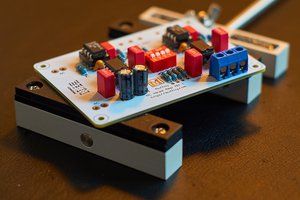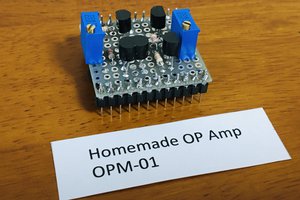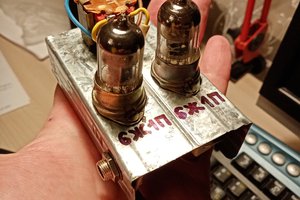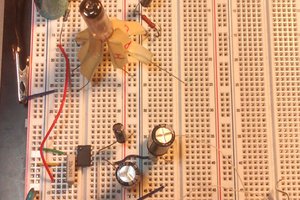headphone-jack
------------------------
An easy hack: adding a switch to switch between speaker and headphone jack (I did not have a switching headphone jack) and leading the output from the LM386 through a 500Ohm-pot as master-volume control.
Pitch-bend
----------------
Toy-keyboards usually have a resistor somewhere that defines the pitch (tone height). It can be found by shorting out random resistors on the circuit board with a 10-20KOhm resistor and checking whether the tone changes. My keyboard had a 100KOhm pitch resistor which I replaced with a 500KOhm pot. A 50K resistor in row and a 500KOhm resistor parallel to the pot make sure that the total resistance varies between 50K and 250K when I spin the knob. I can tune the keyboard one octave down and one octave up.
Effects:
-----------
Both effects can be used individually or chained together, see schematics. The output from the keyboard's signal generator goes (after the original volume slider) into the reverb-amp and then into the overdrive amp.
Overdrive
--------------
A stereo headphone amp circuit taken from an under-a-DELL-monitor speaker is wired in a way that the output of one channel goes into the input of the other one. The gain-pot is between the two amps, the vol-pot after the second amp. I also changed the input-capacitors of the amps to larger ones (1uF) to get more bass. Two amps in a row create quite some noise, so I added a low-pass filter after the second amp. The filter consists of a capacitor to ground after a resistor and gets rid of the noise.
Reverb
-----------
Two speakers taken from the aforementioned DELL-speaker are attached to a wooden ruler. The membranes of the speakers are attached to the side of a metal spring, which is put under tension. The spring is wound from old guitar strings of different thickness which I have soldered together. One speaker vibrates the spring and the other speaker acts as microphone to take up the vibrations.
A TDA2022-based amp from cheap multimedia speakers is used to power the reverb. One channel drives the speaker, the other channel amplifies the input from the speaker that acts as microphone. The signal from the keyboard goes via a 50% voltage divider into the amp that drives the spring. The gain-pot is a 500Ohm pot that sits between the microphone-speaker and the second amp, the volume-pot adjusts the output-level after the amplification. The amp has a bad cross-signal shielding, so the output is always a mix between the signal that comes through the spring and the original signal. It also tends to distort and wildly oscillate when the pots are set too high.
The video with a musical demonstration is embedded above.
 joekutz
joekutz

 Mitsuru Yamada
Mitsuru Yamada
 Maxim Fyodorov
Maxim Fyodorov
 Brandon Foltz
Brandon Foltz
Hi, could you please post a picture of the location of the pitch resistance ? I have trouble to find it, i found some spot around what you show but that can only speed up and i want to get down.
Thank you for your work :)
Theo